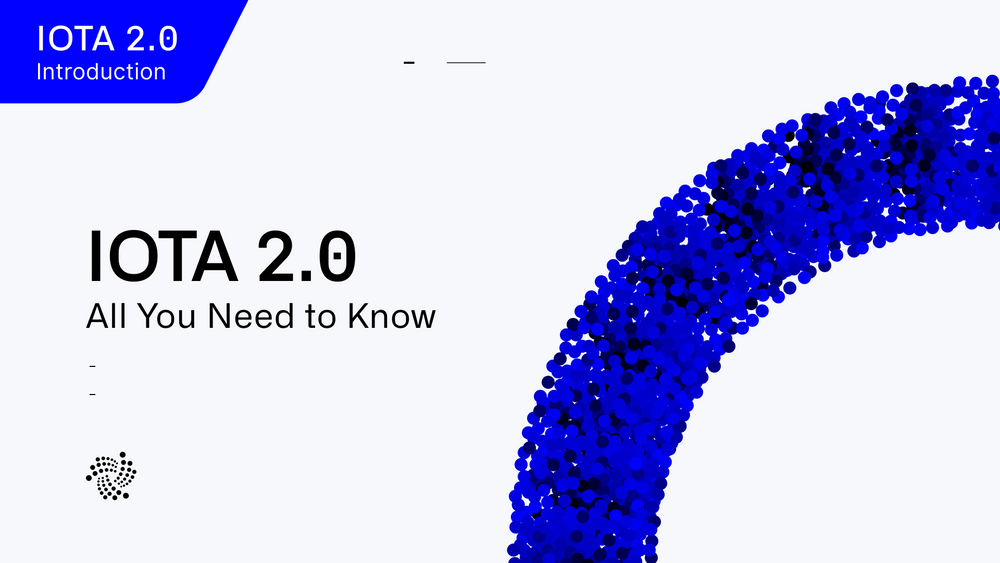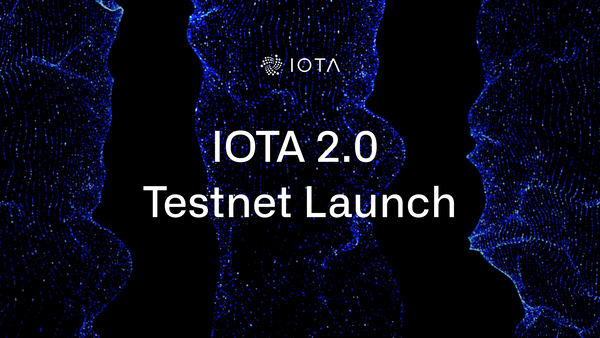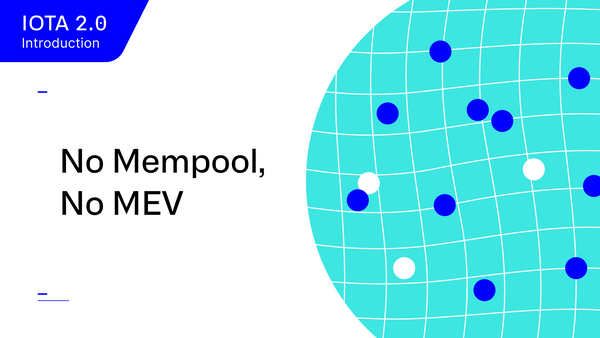IOTA 2.0: All You Need to Know
An Index of All Introductory Content for IOTA 2.0
TL;DR:
This page lists all content released since October 2023 as part of the introduction to the upcoming IOTA 2.0 protocol upgrade.
Taking place in 2024, the IOTA 2.0 protocol upgrade is a groundbreaking improvement for the IOTA network. First as a testnet in Q1 before moving onto Shimmer and finally IOTA mainnet, its enhancements include uninterrupted transaction processing during disruptions, swift and democratic consensus, increased decentralization, and robust security features. IOTA 2.0 also introduces diverse output types, sustainable tokenomics, feeless transactions for token holders, and advanced protection against MEV manipulation. Beyond technicalities, IOTA 2.0 encourages active and long-term engagement, offering rewards through staking or delegating tokens. And that’s just the tip of the iceberg.
Over the past few months, we’ve introduced all aspects of IOTA 2.0 across blog posts, Wiki articles, videos, presentations, and more. Together they are blueprints for a future where everyone can enjoy digital autonomy. We’ve listed them here as a convenient starting point for your exploration of IOTA 2.0.
Blog Posts

The starting point for your journey into IOTA 2.0, our series of blog posts starts with the general vision behind IOTA 2.0 before addressing the architecture, consensus, and tokenomics of the protocol upgrade.
Part 1: Digital Autonomy for Everyone: The Future of IOTA. The vision behind IOTA 2.0.
Part 2: Five Principles: The Fundamentals That Every DLT Needs. The principles that informed the design of IOTA 2.0.
Part 3: Data Flow Explained: How Nodes Process Blocks. How each module of the IOTA 2.0 protocol interacts with the data you share with it.
Part 4: Data Structures Explained: The Building Blocks that Make the Tangle. The vital structures of IOTA 2.0 - blocks, slot commitments, and payloads.
Part 5: Accounts, Tokens, Mana and Staking. The key elements of IOTA 2.0’s tokenomics.
Part 6: A New Consensus Model: Nakamoto Consensus on a DAG: The consensus mechanism of IOTA 2.0, and how every participant can agree on what's stored and valid in the ledger.
Part 7: Confirming Blocks: How Validators Operate. The role of validator nodes in the consensus mechanism, how they form and how they are rewarded.
Part 8: Congestion Control: Regulating Access in a Permissionless System. How IOTA 2.0 manages congestion and ensures fair throughput with predictable fees.
Part 9: Finality Explained: How Nodes Sync the Ledger. How slot commitment chains help achieve finality in IOTA 2.0 by synchronizing the ledger.
Part 10: An Obvious Choice: Why DAGs Over Blockchains? The benefits of a Directed Acyclic Graph architecture as opposed to traditional blockchain.
Part 11: What Makes IOTA 2.0 Secure? How IOTA 2.0 will secure the Tangle (the underlying data structure of the IOTA DLT) against attacks and exploitations.
Part 12: Dynamic Availability: Protocol-Based Assurances. IOTA 2.0 combines dynamic availability - where the network won’t halt even if a majority of nodes disconnect - with definite finality.
Part 13: Fair Tokenomics for all Token Holders. Why IOTA 2.0’s tokenomics is designed to be sustainable and predictable for all users.
Part 14: UTXO vs Accounts: Merging the Best of Both Worlds. IOTA 2.0 combines the best of the UTXO and Account models for digital asset ownership, especially tokens.
Part 15: No Mempool, No MEV: Protecting Users Against Value Extraction. How mempools enable Maximal Extractable Value in blockchains and how IOTA 2.0 circumvents this.
Part 16: Accessible Writing: Lowering the Barriers to Entry. How IOTA 2.0, enables its users to interact with the ledger without barriers.
Wiki Articles

The ideas presented in the blog posts and videos can be explored in more detail on the IOTA Wiki.
- Digital Autonomy for Everyone and Five Principles
- Data Flow
- Data Structures
- Tokenomics: Mana, Accounts, Staking and Delegating
- Mana Calculator
- Consensus
- Consensus on a DAG
- Preliminaries
- Tip Selection Algorithm
- Consensus Flags
- Chain Switching Rule
- Relevant Algorithms - Validators, Their Selection, and Rotation
- Communication layer: Congestion control, block creation, and processing
Videos

Taking their cues from the blog posts, short, sharp videos deliver IOTA 2.0 ideas in a nutshell:
- Digital Autonomy for Everyone
- Five DLT Principles of IOTA 2.0
- Mana on IOTA 2.0
- Revolutionizing Consensus with IOTA 2.0
- Securing Consensus with Slot Commitment Chains on IOTA 2.0
- Confirmation and Finality on IOTA 2.0
- Delegating and Validating on IOTA 2.0
- IOTA 2.0's Sustainable Tokenomics
- Powerful Transactions on IOTA 2.0
- Better Processing with IOTA 2.0
Q&As and Presentations

With much of the introduction campaign out in front of the public, Billy Sanders, our Director of Research, took time out to explain how IOTA 2.0 will work live on our Discord channel - you can re-watch the video on our YouTube channel.
In a follow-up online Q&A session, also held on Discord, community members asked several questions to Billy as well as Andrew Cullen, Andrea Villa, Darcy Camargo, Nikita Polianskii, and Piotr Macek from our team of researchers and engineers. You can watch the video here or read the transcript here.
Finally, Dr. Olivia Saa, Senior Research scientist at the IOTA Foundation gives an overview of the incentives and tokenomics behind IOTA 2.0. You can follow up by looking through the Incentives and Tokenomics whitepaper itself here.
IOTAdvent Series
Sharing a snippet about why we do things the way we do in IOTA 2.0: A series by Sebastian Mueller.
Day 1 - We let users build blocks on their own because this decreases the dependency on miners or validators which is necessary for digital autonomy.
Day 2 - Our blocks reference more than one previous block because this creates the DAG structure, which is essential for higher throughput without compromising security.
Day 3 - We use reality-based UTXOs because this allows us to optimistically progress the ledger state without having to wait for final confirmation of all transactions.
Day 4 - In IOTA, we use On-Tangle-Voting (OTV) to resolve conflicts because it allows us to treat each transaction block separately while still being efficient.
Day 5 - We use a validator committee to achieve faster confirmations and facilitate consensus.
Day 6 - We distinguish between acceptance and confirmation because it allows dynamic availability.
Day 7 - We distinguish between pre-confirmation and confirmation because it ensures both efficiency and security in the IOTA network.
Day 8 - We use commitments because this allows us to have deterministic finality, a crucial aspect for the network's reliability and security.
Day 9 - We use commitment chains in IOTA for efficient synchronization of the network.
Day 10 - We employ pruning in IOTA to reduce storage requirements for nodes by removing already processed data, thereby maintaining the network’s scalability and efficiency.
Day 11 - We use Mana for access control because we do not want to pay fees.
Day 12 - We use two types of access controls, enabling openness in uncongested times and fairness during congestion.
Day 13 - We burn Mana on block creation because we do not have a mempool.
Day 14 - We do not use a first-price auction in times of congestion because it gives loyal users guaranteed bandwidth.
Day 15 - We use adaptive Mana burn to prevent discouraging whales from spamming the network to earn more from selling their bandwidth.
Day 16 - We use two distinct types of blocks — basic and validation blocks — to enhance network efficiency without compromising general writing access.
Day 17 - We use validators and validators blocks to get a confirmation time of around 1 second.
Day 18 - We have Mana on accounts and UTXOs to have the best parts of both worlds.
Day 19 - We reward validators with Mana and not IOTA, because this creates no token inflation or fees.
Day 20 - We have a 3:2:1 formula for Mana rewards to reward the different degrees of participation.
Day 21 - We reward good performance and penalize malicious validators by slashing their Mana to increase the number of delegated and staked tokens.
Day 22 - Mana slowly decays over time to be open for future participation.
Day 23 - We use Mana as the key of access control because it is only the first step.
Day 24 - We break the chains because we want to be free.
IOTA 2.0 in 2024
From foundational principles to consensus models, the educational material listed above provided our community with an understanding of IOTA 2.0. As we await the protocol's implementation, first as a testnet then in full on the mainnet, the introduction campaign serves as a practical roadmap for our journey towards a decentralized future.




